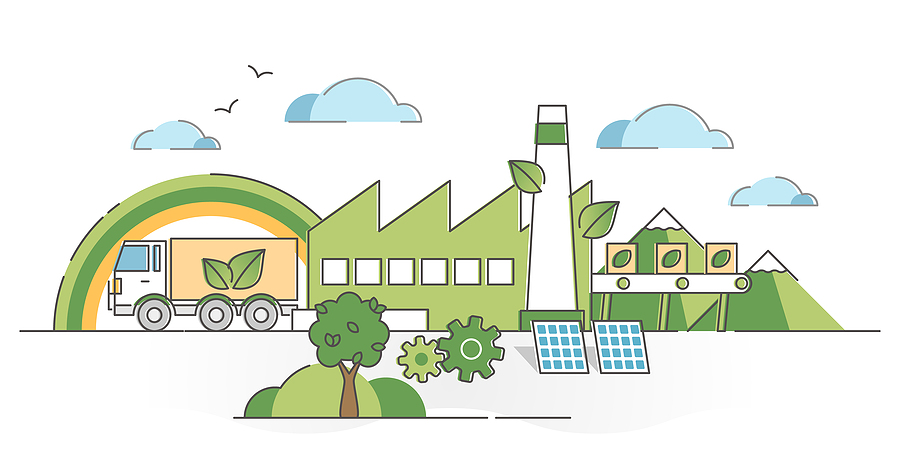
Sustainability Challenges and the 5 Opportunities for Manufacturers to Go Green
All roads are leading most industries to adopt increasingly more sustainable practices. The pressure for manufacturers to go green is growing in the face of climate change, supply chain challenges and especially consumer preferences.
A report from the Roundup, “Environmentally Conscious Consumer Statistics,” paints a pretty clear picture.
- Products marketed as sustainable grew 2.7x faster than those that were not.
- 78% of consumers feel that sustainability is important.
- The sale of carbon labeled products (such as those with 1% For the Planet or Climate Neutral Certification) doubled in one year, reaching $3.4 billion in 2021.
- 62% of people say they “always or often” seek products to purchase because they are sustainable, which is up from just 27% in 2021.
Consumers are opting for products that are sustainable, but that’s not the only headline for manufacturers. Because, it’s not just products. It’s the companies, too. Some 29% of consumers said they are “often or always” influenced by a company’s commitment to adopting more sustainable practices.
Sustainability challenges: It’s not easy being green
Many in the manufacturing industry are undoubtedly feeling some kinship to Kermit the Frog these days. Despite the pressure to adopt more sustainable practices, as the Muppet so famously lamented: “It’s not easy being green.”
It’s all well and good to work toward shoring up the environment (and we need to) but it’s a challenging lift for manufacturers. Some obstacles include:
High upfront costs. New technologies, processes and materials come at a price. It’s especially tough for manufacturers in industries like food and beverage, which has razor-thin margins.
Long wait for return-on-investment. ROI from major expenses can take years to come to fruition.
Supply chain challenges. Even if your company has shifted to more sustainable practices, what about your suppliers?
Skilled labor shortage. It’s difficult enough to find warm bodies to work on the line. But new technologies come with new skills requirements.
Opportunities are emerging
At USC Consulting Group, we help companies look for the opportunities within challenging situations. We always find the silver linings. Here are a few:
Cost reduction. Yes, there are upfront costs. But sustainable practices can lead to reduced energy and water consumption, the possibility of lower regulatory compliance costs, and lower materials costs by using recycled materials.
New partners, suppliers and revenue streams. The sustainable marketplace is an ecosystem all its own. It’s possible to find new partners, customers and even suppliers.
Attract and retain top talent. Yes, there is a labor shortage. But the companies with strong sustainable practices are attracting the best people out there. Companies that care for the environment also find their employees are more engaged and involved.
Governmental tax breaks. The government is committed to rewarding companies for adopting more sustainable practices with tax breaks and other financial incentives.
Strategies for manufacturers
One of the best ways to adopt more sustainable practices is to first look in the mirror. It’s not necessarily about investing in new technologies and turning the world upside down. First, look at your processes and operating systems. You’ll likely find efficiencies you didn’t even know were there. Places to start:
Minimizing waste. Lean Six Sigma methodologies can find hidden wastes and lead to more efficient operations. Not only will it save you considerable money, but minimizing waste is a key principle in sustainability. That’s a win-win.
Operations improvements. How efficient are your operations? A solid management operations system, which is a structured approach to your operations, creates much greater efficiency. The best MOS focus on processes, systems, roles and structures to map out how the job gets done, and by whom. Learn more about it in our short video, Stop the Firefighting Mentality to Improve Your Bottom Line.
Sales, inventory and operations planning. You’ve heard of S&OP. We added the “I.” We find inventory to be a key piece of the operations puzzle. When doing sales forecasting and planning for demand and supply, adding inventory elevates the process a notch. It makes inventory a strategic tool. Learn more about it in our free eBook, “Sales, Inventory and Operations Planning: It’s About Time.”
Training. About that skilled labor shortage. A way to combat that is by training and upskilling your people. And solid training for not just employees on the line but managers, too, will get everyone on the same page, creating greater efficiency organization-wide.
By moving toward more sustainable practices, manufacturers can ultimately reduce costs, find greater efficiencies, attract both consumers and employees and help the planet in the process. But it’s not easy. At USC Consulting Group, we’re the experts on helping companies become more efficient, effective and profitable. With more than 55 years behind us, we’ve seen trends come and go. The key is turning challenges into opportunities. Get in touch to find out more.






